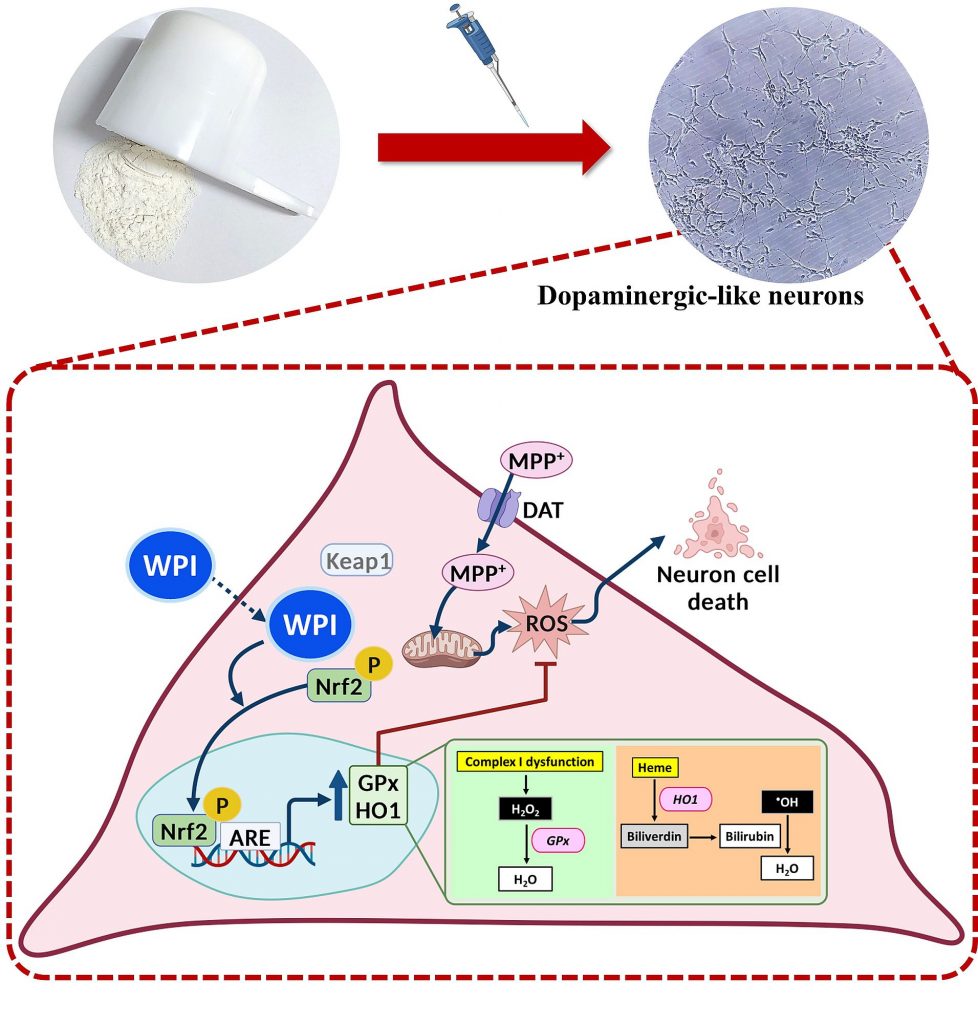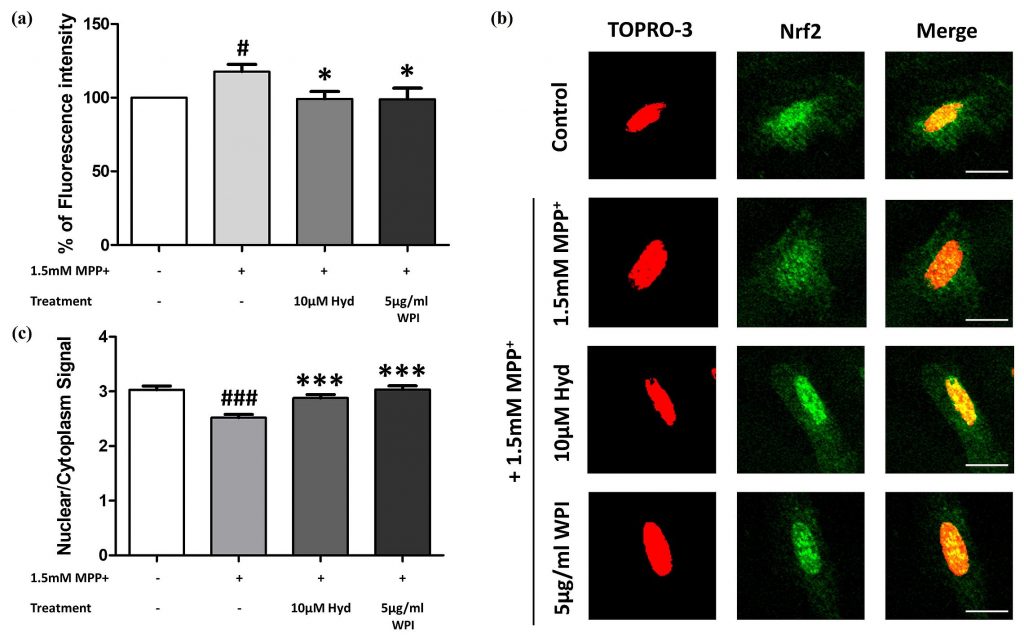

Highlight
This study demonstrates that whey protein isolate (WPI) protects dopaminergic-like SH-SY5Y cells from MPP⁺-induced oxidative stress by activating the Nrf2 signaling pathway. WPI significantly reduced intracellular ROS levels, increased Nrf2 nuclear translocation, and upregulated key antioxidant genes, supporting its potential as a neuroprotective agent in Parkinson’s disease cellular models.
ที่มาและความสำคัญ
โรคพาร์กินสัน (Parkinson’s disease: PD) เป็นโรคทางระบบประสาทที่เสื่อมเรื้อรัง มีลักษณะเด่นคือการสูญเสียเซลล์ประสาทโดพามิเนอร์จิกในสมองส่วน substantia nigra pars compacta ซึ่งนำไปสู่การเคลื่อนไหวช้า กล้ามเนื้อแข็งเกร็ง และอาการสั่น สาเหตุของโรคมีความซับซ้อนและเกี่ยวข้องกับหลายปัจจัย โดยเฉพาะความเครียดออกซิเดชัน (oxidative stress) จากการสะสมของอนุมูลอิสระ (ROS) ซึ่งเป็นตัวการสำคัญที่เร่งการเสื่อมของเซลล์ประสาท กลไกสำคัญในการป้องกันความเสียหายจากอนุมูลอิสระในร่างกายคือ เส้นทางสัญญาณ Nrf2 ซึ่งทำหน้าที่กระตุ้นการแสดงออกของยีนที่เกี่ยวข้องกับการต้านอนุมูลอิสระ เช่น SOD1, GST, GPX, HMOX1 และ NQO1 โดยปกติ Nrf2 จะถูกยับยั้งในไซโตพลาสซึม แต่เมื่อเกิดภาวะเครียดออกซิเดชัน Nrf2 จะถูกปลดปล่อยและเคลื่อนเข้าสู่นิวเคลียสเพื่อกระตุ้นยีนเหล่านี้ เวย์โปรตีนไอโซเลต (Whey Protein Isolate: WPI) เป็นโปรตีนบริสุทธิ์สูงจากนมวัว มีคุณสมบัติโดดเด่นในด้านความสามารถในการละลายน้ำ ย่อยง่าย และมีกรดอะมิโนจำเป็นครบถ้วน หลายการศึกษารายงานว่า WPI และเปปไทด์ที่ได้จากการย่อยเวย์มีฤทธิ์ต้านอนุมูลอิสระ ช่วยเสริมการสร้างกลูตาไธโอน และควบคุมสภาวะรีดอกซ์ในเซลล์ รวมถึงอาจลดการอักเสบในระบบต่าง ๆ ของร่างกาย การศึกษานี้มีความสำคัญ เนื่องจากมุ่งประเมินศักยภาพของ WPI ในการปกป้องเซลล์ประสาทจากความเสียหายที่เกิดจาก MPP⁺ ผ่านกลไกการลดระดับ ROS, กระตุ้นการเข้าสู่นิวเคลียสของ Nrf2 และการกระตุ้นยีนต้านอนุมูลอิสระ เพื่อให้เข้าใจถึงกลไกการออกฤทธิ์ของ WPI ในการป้องกันโรคพาร์กินสันระดับเซลล์ ซึ่งอาจเป็นแนวทางใหม่ในการพัฒนาอาหารฟังก์ชันหรือผลิตภัณฑ์เสริมอาหารสำหรับผู้ป่วยโรคพาร์กินสันในอนาคต
Abstract
The pathogenesis of Parkinson’s disease (PD) consists of the apoptosis of dopaminergic neurons in the substantia nigra pars compacta (SNpc) due to oxidative stress. The present study aimed to evaluate the potential antioxidant activity of whey protein isolate (WPI) in PD models, using neurotoxin-exposed SH-SY5Y cells differentiated into dopaminergic-like neurons. Our research shows that WPI’s high glutamic acid, aspartic acid, and leucine contribute to its antioxidant and neuroprotective effects, with glutamic acid crucial for glutathione synthesis. In vitro studies found that WPI, at concentrations of 5–1000 µg/mL, is non-toxic to differentiated SH-SY5Y cells. Notably, the lowest con-centration of WPI (5 µg/mL) significantly decreased intracellular reactive oxygen species (ROS) levels in these cells following a 24 h co-treatment with 1-methyl-4-phenylpyridinium (MPP+). The antioxidant effects of WPI were also confirmed by the increased expression of HO1 and GPx antioxidant enzymes, which are Nrf2 pathway target genes and were evaluated by real-time PCR. Furthermore, Nrf2 nuclear translocation in the differentiated SH-SY5Y cells was also increased when the cells were exposed to 5 µg/mL of WPI with MPP+. These results together suggest that WPI has antioxidant effects on dopaminergic-like neurons in a Parkinson’s disease model.
KEYWORDS: Parkinson’s disease, whey protein isolate, MPP+, Nrf2, antioxidant
Citation: Rungruang, P., Sroyraya, M., & Sansri, V. (2025). Protective Role of Whey Protein Isolate on MPP+-Induced Differentiation of SH-SY5Y Cells by Modulating the Nrf2 Antioxidant Pathway. Molecules, 30(10), 2207; https://doi.org/10.3390/molecules30102207
RELATED SDGs:
SDG Goal หลัก ที่เกี่ยวข้อง
3. GOOD HEALTH AND WELL-BEING

ผู้ให้ข้อมูล: ผู้ช่วยศาสตราจารย์ ดร.มรกต สร้อยระย้า
ชื่ออาจารย์ที่ทำวิจัย: ผู้ช่วยศาสตราจารย์ ดร.มรกต สร้อยระย้า
ชื่อนักศึกษาที่ทำวิจัย: Panlekha Rungruang
Credit ภาพ: ผู้ช่วยศาสตราจารย์ ดร.มรกต สร้อยระย้า
Tags: Antioxidant, MPP+, Nrf2, Parkinson’s Disease, whey protein isolate
